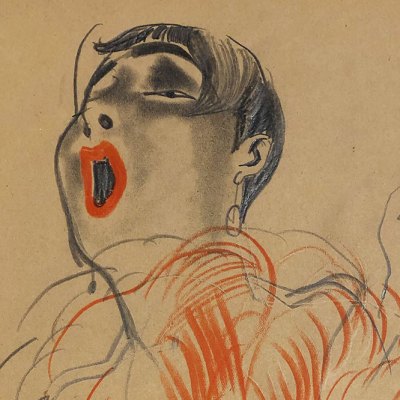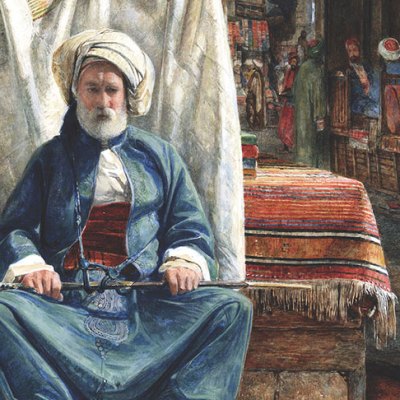In 1917, the writer, publisher, designer, and Arts and Crafts pioneer C.R. Ashbee (1863–1942) found himself working as a teacher at a school in Cairo. Ashbee was a socialist in the William Morris mould, who endlessly romanticised the uncorrupted folk art of the pre-industrial age. So, when he was taken to see an Arabic dramatic performance in a village about an hour outside Cairo, he could scarcely contain his excitement.
In his diary, now held in the archives of King’s College Cambridge, he boasted, ‘I have had a great experience. I’ve seen real living Shakespearean popular drama – tragedy as it must have been played in Europe 250 years ago. Bernard Shaw, Masefield and Barker would give their eyes for it.’ The drama was acted on a stage backed with hangings ‘of gorgeous colours, in bright Arabic patterns; they were fastened to great masts and hung on 4 huge palm trees through the open tops of which you saw the stars and the moon.’
Perhaps most of all he was amazed by the main actress, Mounira, who not only charmed the audience during the play but returned afterwards to sing several songs as an encore. They had been there for five hours, he said, but still the crowd’s ‘pent up emotions were let loose and they cheered to the echo – “Allah! Allah! May God protect your voice!”’
If Ashbee had not been quite so obsessed with the ‘elemental’ antiquity of the scene, he might have found out that this singer was Mounira al-Mahdiyya, one of the biggest stars of Egypt’s modern nightlife scene. After coming to Cairo in 1905 she had made a living singing in the city’s seedy nightclubs.
The Egyptian singer and actress Mounira al-Mahdiyya (1885–1965), photographed in the 1920s. Courtesy the Abushady Archive

Less than two years before Ashbee saw her performance in that village, she had left behind the life of a nightclub singer to make her theatrical debut on the stage of the Printania Theatre on Alfi Bey Street. She was said to be the first Egyptian Muslim woman to become a professional actress – before then actresses had largely been Christian or Jewish and from Ottoman Syria. The next year she became the first Egyptian woman to lead her own theatrical company.
Long after Ashbee saw her, Mounira remained one of the biggest names of the riotous underworld of parties and nightlife that flourished in Cairo throughout the 1920s and ’30s. In this period, downtown Cairo was thick with theatres, cabarets, dancehalls, and cinemas, and had an entertainment scene to rival other global cities – Berlin, Paris, or New York.
The geographical centre of this late-night world was an area called Ezbekiyya in downtown Cairo. A vast array of venues, sometimes literally stacked one on top of the other, gave their audiences a selection of popular singers, comic variety acts, flamboyant melodramas and more, while champagne and other drinks flowed in sometimes embarrassing quantities.
Last November, I was in Egypt doing research for a book about the many women performers – actresses, singers and dancers – who were making careers for themselves in front of Cairo’s audiences. I spent several hours walking around Ezbekiyya in search of its past.
Of course, between its pharaonic and Islamic past, Egypt already has an enormous number of heritage sites (as the old joke goes: Egypt’s heritage is so rich that even after millennia of being robbed it is still full of treasures). But this 20th-century history, with its intriguing cosmopolitan glamour, is starting to attract more attention. All across downtown, blue plaques, like those in the UK, have been going up giving information about buildings and their former residents.
Unfortunately, most traces of Cairo’s early 20th-century nightlife have now disappeared: the Cairo fire of 1952 destroyed many places; other theatres and cabarets became cinemas which now mostly sit derelict or sparsely attended. In 1971 the famous Opera House, built in 1869, which hosted the premiere of Verdi’s Aida, burned down.
But walking through the streets of Ezbekiyya I could still find vestiges of this old world. The facade of the Printania Theatre, where Mounira al-Mahdiyya made her acting debut in 1915, still towers above Alfi Bey Street – inside are now the Alfi Bey Restaurant, a sad-looking cinema and, on the upper floors, the Scheherazade cabaret. On Bab al-Bahri street, the shell of the Alhambra Casino still survives, where the singer Naima al-Masriyya performed throughout the 1920s and where the former French prime minister George Clemenceau was so impressed he sent her a bottle of champagne. Inside, it is an auto parts shop.
The only place that is still going in roughly the same form as in the ’20s is the Naguib al-Rihani Theatre on Emad al-Din Street. It started life as the Radium cinema in the 1910s, then in 1923 became the Ramses Theatre. Since then it has been through a series of rebrands and refurbishments – and was probably where André Gide came to watch a play when he was in Cairo after the Second World War – but continues to function as a theatre today.
Despite C.R. Ashbee’s fantasy of a world untouched by modernity, Cairo was on the verge of its Roaring Twenties when he came to the country, and the relics of that time now jostle for space in Cairo’s patchwork topography of ages past.
Raphael Cormack is the editor of The Book of Cairo and The Book of Khartoum. His book Midnight in Cairo will be published by SaqiBooks later this year.
From the January 2020 issue of Apollo. Preview and subscribe here.


